Detailed Analysis of Tesco's Growth and Development: A Business Report
VerifiedAdded on 2023/06/08
|12
|3814
|199
Report
AI Summary
This report provides a comprehensive analysis of Tesco's growth and development, examining various aspects of its business operations. It begins with an introduction to Tesco, outlining its vision and objectives, followed by an evaluation of management support in operations, particularly in relation to the company's aims. The report delves into the significance of management approaches in business management, including both behavioral and classical approaches. Furthermore, it analyzes the importance of motivation in the workplace, highlighting its impact on productivity, innovation, and employee retention. The report also explores how effective communication and teamwork contribute to improved business performance. Overall, the report offers valuable insights into Tesco's strategies for achieving organizational growth and success.

The Growth and
Development of an
Organization
Development of an
Organization
Paraphrase This Document
Need a fresh take? Get an instant paraphrase of this document with our AI Paraphraser
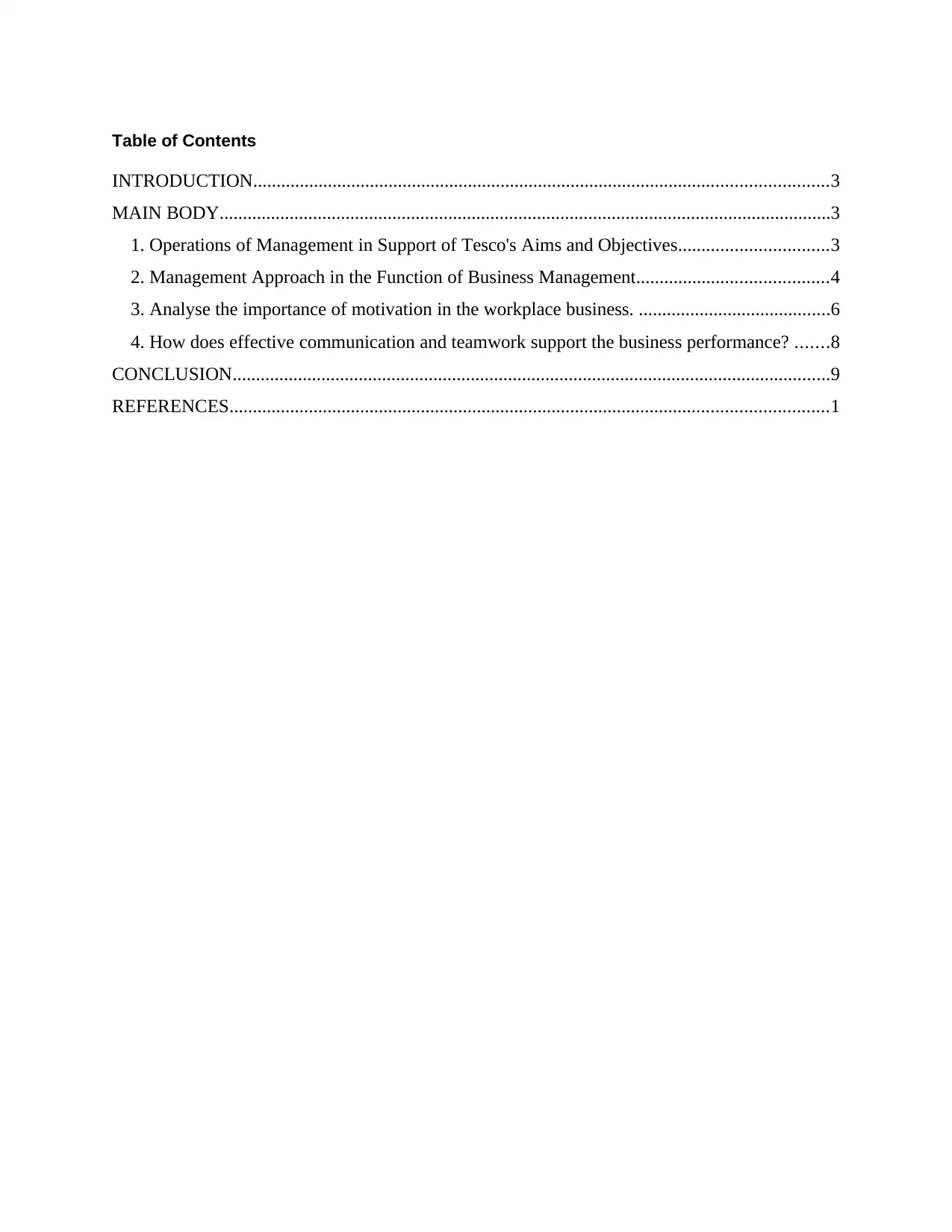
Table of Contents
INTRODUCTION...........................................................................................................................3
MAIN BODY...................................................................................................................................3
1. Operations of Management in Support of Tesco's Aims and Objectives................................3
2. Management Approach in the Function of Business Management.........................................4
3. Analyse the importance of motivation in the workplace business. .........................................6
4. How does effective communication and teamwork support the business performance? .......8
CONCLUSION................................................................................................................................9
REFERENCES................................................................................................................................1
INTRODUCTION...........................................................................................................................3
MAIN BODY...................................................................................................................................3
1. Operations of Management in Support of Tesco's Aims and Objectives................................3
2. Management Approach in the Function of Business Management.........................................4
3. Analyse the importance of motivation in the workplace business. .........................................6
4. How does effective communication and teamwork support the business performance? .......8
CONCLUSION................................................................................................................................9
REFERENCES................................................................................................................................1
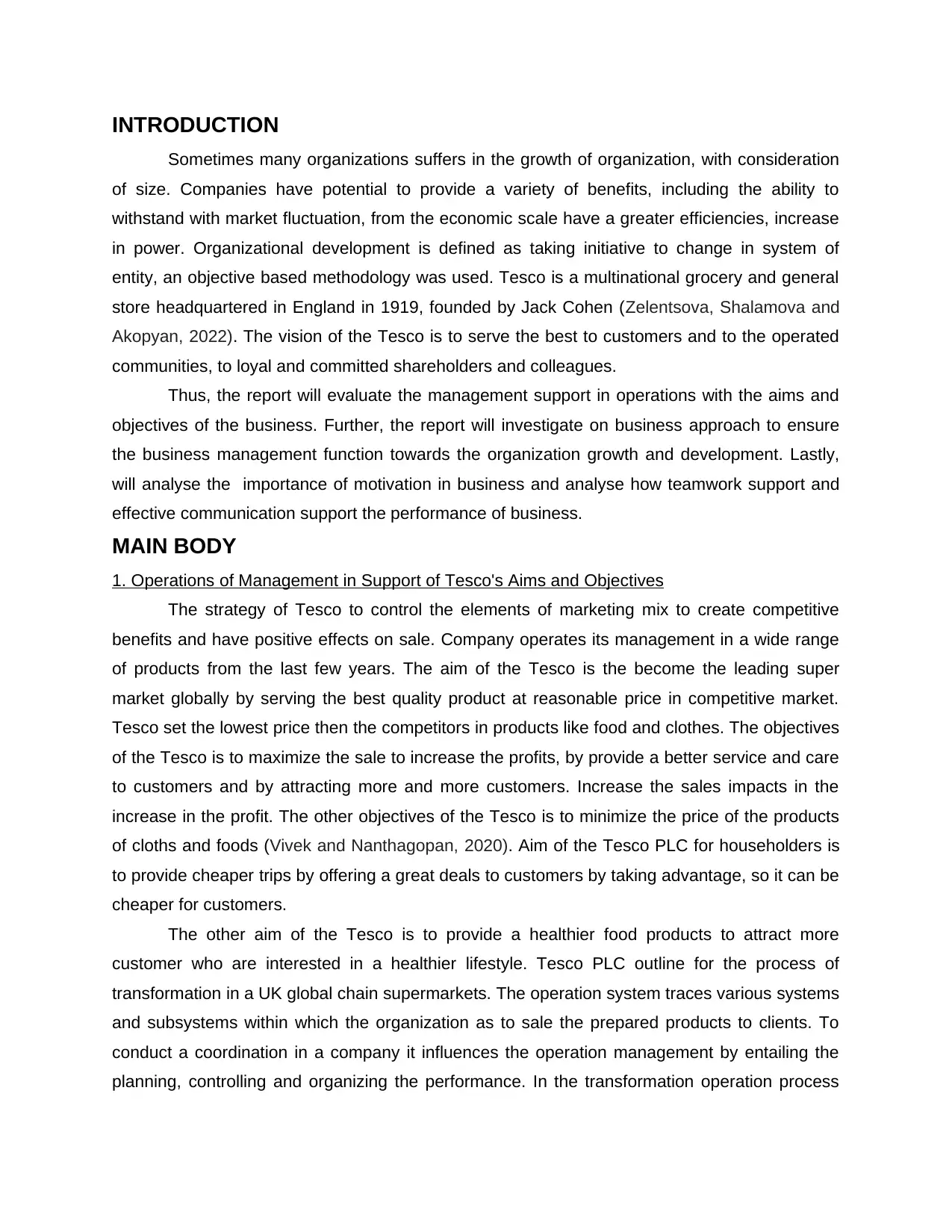
INTRODUCTION
Sometimes many organizations suffers in the growth of organization, with consideration
of size. Companies have potential to provide a variety of benefits, including the ability to
withstand with market fluctuation, from the economic scale have a greater efficiencies, increase
in power. Organizational development is defined as taking initiative to change in system of
entity, an objective based methodology was used. Tesco is a multinational grocery and general
store headquartered in England in 1919, founded by Jack Cohen (Zelentsova, Shalamova and
Akopyan, 2022). The vision of the Tesco is to serve the best to customers and to the operated
communities, to loyal and committed shareholders and colleagues.
Thus, the report will evaluate the management support in operations with the aims and
objectives of the business. Further, the report will investigate on business approach to ensure
the business management function towards the organization growth and development. Lastly,
will analyse the importance of motivation in business and analyse how teamwork support and
effective communication support the performance of business.
MAIN BODY
1. Operations of Management in Support of Tesco's Aims and Objectives
The strategy of Tesco to control the elements of marketing mix to create competitive
benefits and have positive effects on sale. Company operates its management in a wide range
of products from the last few years. The aim of the Tesco is the become the leading super
market globally by serving the best quality product at reasonable price in competitive market.
Tesco set the lowest price then the competitors in products like food and clothes. The objectives
of the Tesco is to maximize the sale to increase the profits, by provide a better service and care
to customers and by attracting more and more customers. Increase the sales impacts in the
increase in the profit. The other objectives of the Tesco is to minimize the price of the products
of cloths and foods (Vivek and Nanthagopan, 2020). Aim of the Tesco PLC for householders is
to provide cheaper trips by offering a great deals to customers by taking advantage, so it can be
cheaper for customers.
The other aim of the Tesco is to provide a healthier food products to attract more
customer who are interested in a healthier lifestyle. Tesco PLC outline for the process of
transformation in a UK global chain supermarkets. The operation system traces various systems
and subsystems within which the organization as to sale the prepared products to clients. To
conduct a coordination in a company it influences the operation management by entailing the
planning, controlling and organizing the performance. In the transformation operation process
Sometimes many organizations suffers in the growth of organization, with consideration
of size. Companies have potential to provide a variety of benefits, including the ability to
withstand with market fluctuation, from the economic scale have a greater efficiencies, increase
in power. Organizational development is defined as taking initiative to change in system of
entity, an objective based methodology was used. Tesco is a multinational grocery and general
store headquartered in England in 1919, founded by Jack Cohen (Zelentsova, Shalamova and
Akopyan, 2022). The vision of the Tesco is to serve the best to customers and to the operated
communities, to loyal and committed shareholders and colleagues.
Thus, the report will evaluate the management support in operations with the aims and
objectives of the business. Further, the report will investigate on business approach to ensure
the business management function towards the organization growth and development. Lastly,
will analyse the importance of motivation in business and analyse how teamwork support and
effective communication support the performance of business.
MAIN BODY
1. Operations of Management in Support of Tesco's Aims and Objectives
The strategy of Tesco to control the elements of marketing mix to create competitive
benefits and have positive effects on sale. Company operates its management in a wide range
of products from the last few years. The aim of the Tesco is the become the leading super
market globally by serving the best quality product at reasonable price in competitive market.
Tesco set the lowest price then the competitors in products like food and clothes. The objectives
of the Tesco is to maximize the sale to increase the profits, by provide a better service and care
to customers and by attracting more and more customers. Increase the sales impacts in the
increase in the profit. The other objectives of the Tesco is to minimize the price of the products
of cloths and foods (Vivek and Nanthagopan, 2020). Aim of the Tesco PLC for householders is
to provide cheaper trips by offering a great deals to customers by taking advantage, so it can be
cheaper for customers.
The other aim of the Tesco is to provide a healthier food products to attract more
customer who are interested in a healthier lifestyle. Tesco PLC outline for the process of
transformation in a UK global chain supermarkets. The operation system traces various systems
and subsystems within which the organization as to sale the prepared products to clients. To
conduct a coordination in a company it influences the operation management by entailing the
planning, controlling and organizing the performance. In the transformation operation process
⊘ This is a preview!⊘
Do you want full access?
Subscribe today to unlock all pages.

Trusted by 1+ million students worldwide
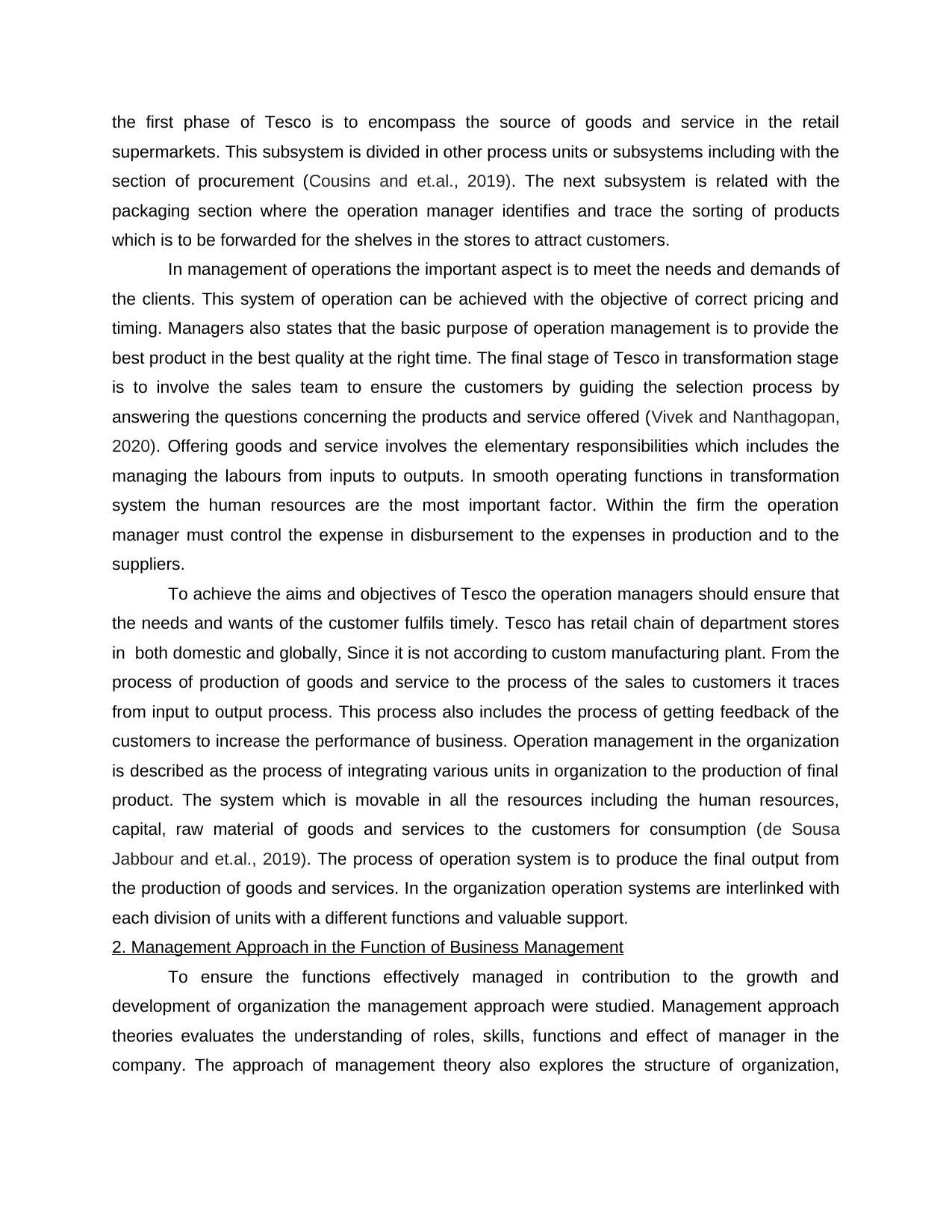
the first phase of Tesco is to encompass the source of goods and service in the retail
supermarkets. This subsystem is divided in other process units or subsystems including with the
section of procurement (Cousins and et.al., 2019). The next subsystem is related with the
packaging section where the operation manager identifies and trace the sorting of products
which is to be forwarded for the shelves in the stores to attract customers.
In management of operations the important aspect is to meet the needs and demands of
the clients. This system of operation can be achieved with the objective of correct pricing and
timing. Managers also states that the basic purpose of operation management is to provide the
best product in the best quality at the right time. The final stage of Tesco in transformation stage
is to involve the sales team to ensure the customers by guiding the selection process by
answering the questions concerning the products and service offered (Vivek and Nanthagopan,
2020). Offering goods and service involves the elementary responsibilities which includes the
managing the labours from inputs to outputs. In smooth operating functions in transformation
system the human resources are the most important factor. Within the firm the operation
manager must control the expense in disbursement to the expenses in production and to the
suppliers.
To achieve the aims and objectives of Tesco the operation managers should ensure that
the needs and wants of the customer fulfils timely. Tesco has retail chain of department stores
in both domestic and globally, Since it is not according to custom manufacturing plant. From the
process of production of goods and service to the process of the sales to customers it traces
from input to output process. This process also includes the process of getting feedback of the
customers to increase the performance of business. Operation management in the organization
is described as the process of integrating various units in organization to the production of final
product. The system which is movable in all the resources including the human resources,
capital, raw material of goods and services to the customers for consumption (de Sousa
Jabbour and et.al., 2019). The process of operation system is to produce the final output from
the production of goods and services. In the organization operation systems are interlinked with
each division of units with a different functions and valuable support.
2. Management Approach in the Function of Business Management
To ensure the functions effectively managed in contribution to the growth and
development of organization the management approach were studied. Management approach
theories evaluates the understanding of roles, skills, functions and effect of manager in the
company. The approach of management theory also explores the structure of organization,
supermarkets. This subsystem is divided in other process units or subsystems including with the
section of procurement (Cousins and et.al., 2019). The next subsystem is related with the
packaging section where the operation manager identifies and trace the sorting of products
which is to be forwarded for the shelves in the stores to attract customers.
In management of operations the important aspect is to meet the needs and demands of
the clients. This system of operation can be achieved with the objective of correct pricing and
timing. Managers also states that the basic purpose of operation management is to provide the
best product in the best quality at the right time. The final stage of Tesco in transformation stage
is to involve the sales team to ensure the customers by guiding the selection process by
answering the questions concerning the products and service offered (Vivek and Nanthagopan,
2020). Offering goods and service involves the elementary responsibilities which includes the
managing the labours from inputs to outputs. In smooth operating functions in transformation
system the human resources are the most important factor. Within the firm the operation
manager must control the expense in disbursement to the expenses in production and to the
suppliers.
To achieve the aims and objectives of Tesco the operation managers should ensure that
the needs and wants of the customer fulfils timely. Tesco has retail chain of department stores
in both domestic and globally, Since it is not according to custom manufacturing plant. From the
process of production of goods and service to the process of the sales to customers it traces
from input to output process. This process also includes the process of getting feedback of the
customers to increase the performance of business. Operation management in the organization
is described as the process of integrating various units in organization to the production of final
product. The system which is movable in all the resources including the human resources,
capital, raw material of goods and services to the customers for consumption (de Sousa
Jabbour and et.al., 2019). The process of operation system is to produce the final output from
the production of goods and services. In the organization operation systems are interlinked with
each division of units with a different functions and valuable support.
2. Management Approach in the Function of Business Management
To ensure the functions effectively managed in contribution to the growth and
development of organization the management approach were studied. Management approach
theories evaluates the understanding of roles, skills, functions and effect of manager in the
company. The approach of management theory also explores the structure of organization,
Paraphrase This Document
Need a fresh take? Get an instant paraphrase of this document with our AI Paraphraser
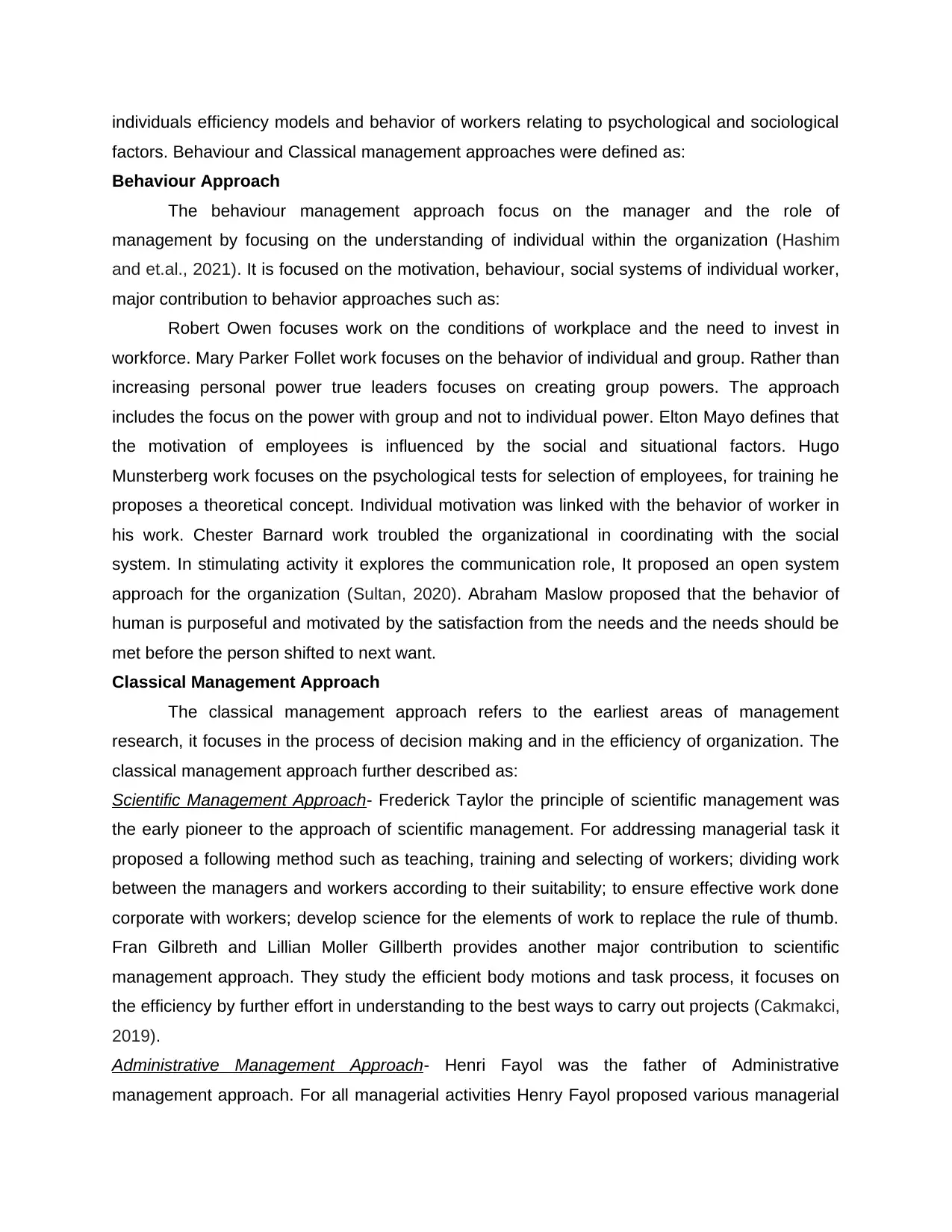
individuals efficiency models and behavior of workers relating to psychological and sociological
factors. Behaviour and Classical management approaches were defined as:
Behaviour Approach
The behaviour management approach focus on the manager and the role of
management by focusing on the understanding of individual within the organization (Hashim
and et.al., 2021). It is focused on the motivation, behaviour, social systems of individual worker,
major contribution to behavior approaches such as:
Robert Owen focuses work on the conditions of workplace and the need to invest in
workforce. Mary Parker Follet work focuses on the behavior of individual and group. Rather than
increasing personal power true leaders focuses on creating group powers. The approach
includes the focus on the power with group and not to individual power. Elton Mayo defines that
the motivation of employees is influenced by the social and situational factors. Hugo
Munsterberg work focuses on the psychological tests for selection of employees, for training he
proposes a theoretical concept. Individual motivation was linked with the behavior of worker in
his work. Chester Barnard work troubled the organizational in coordinating with the social
system. In stimulating activity it explores the communication role, It proposed an open system
approach for the organization (Sultan, 2020). Abraham Maslow proposed that the behavior of
human is purposeful and motivated by the satisfaction from the needs and the needs should be
met before the person shifted to next want.
Classical Management Approach
The classical management approach refers to the earliest areas of management
research, it focuses in the process of decision making and in the efficiency of organization. The
classical management approach further described as:
Scientific Management Approach- Frederick Taylor the principle of scientific management was
the early pioneer to the approach of scientific management. For addressing managerial task it
proposed a following method such as teaching, training and selecting of workers; dividing work
between the managers and workers according to their suitability; to ensure effective work done
corporate with workers; develop science for the elements of work to replace the rule of thumb.
Fran Gilbreth and Lillian Moller Gillberth provides another major contribution to scientific
management approach. They study the efficient body motions and task process, it focuses on
the efficiency by further effort in understanding to the best ways to carry out projects (Cakmakci,
2019).
Administrative Management Approach- Henri Fayol was the father of Administrative
management approach. For all managerial activities Henry Fayol proposed various managerial
factors. Behaviour and Classical management approaches were defined as:
Behaviour Approach
The behaviour management approach focus on the manager and the role of
management by focusing on the understanding of individual within the organization (Hashim
and et.al., 2021). It is focused on the motivation, behaviour, social systems of individual worker,
major contribution to behavior approaches such as:
Robert Owen focuses work on the conditions of workplace and the need to invest in
workforce. Mary Parker Follet work focuses on the behavior of individual and group. Rather than
increasing personal power true leaders focuses on creating group powers. The approach
includes the focus on the power with group and not to individual power. Elton Mayo defines that
the motivation of employees is influenced by the social and situational factors. Hugo
Munsterberg work focuses on the psychological tests for selection of employees, for training he
proposes a theoretical concept. Individual motivation was linked with the behavior of worker in
his work. Chester Barnard work troubled the organizational in coordinating with the social
system. In stimulating activity it explores the communication role, It proposed an open system
approach for the organization (Sultan, 2020). Abraham Maslow proposed that the behavior of
human is purposeful and motivated by the satisfaction from the needs and the needs should be
met before the person shifted to next want.
Classical Management Approach
The classical management approach refers to the earliest areas of management
research, it focuses in the process of decision making and in the efficiency of organization. The
classical management approach further described as:
Scientific Management Approach- Frederick Taylor the principle of scientific management was
the early pioneer to the approach of scientific management. For addressing managerial task it
proposed a following method such as teaching, training and selecting of workers; dividing work
between the managers and workers according to their suitability; to ensure effective work done
corporate with workers; develop science for the elements of work to replace the rule of thumb.
Fran Gilbreth and Lillian Moller Gillberth provides another major contribution to scientific
management approach. They study the efficient body motions and task process, it focuses on
the efficiency by further effort in understanding to the best ways to carry out projects (Cakmakci,
2019).
Administrative Management Approach- Henri Fayol was the father of Administrative
management approach. For all managerial activities Henry Fayol proposed various managerial
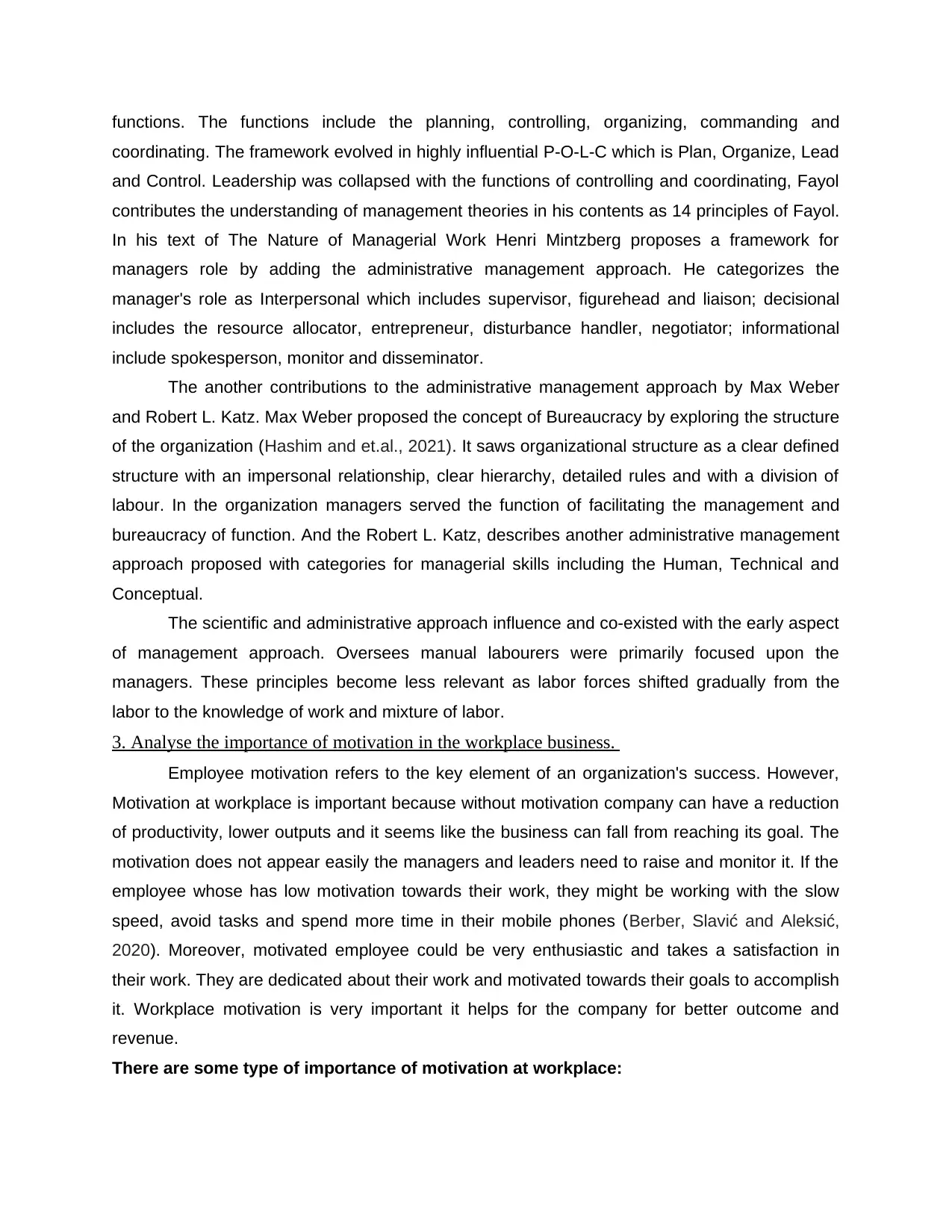
functions. The functions include the planning, controlling, organizing, commanding and
coordinating. The framework evolved in highly influential P-O-L-C which is Plan, Organize, Lead
and Control. Leadership was collapsed with the functions of controlling and coordinating, Fayol
contributes the understanding of management theories in his contents as 14 principles of Fayol.
In his text of The Nature of Managerial Work Henri Mintzberg proposes a framework for
managers role by adding the administrative management approach. He categorizes the
manager's role as Interpersonal which includes supervisor, figurehead and liaison; decisional
includes the resource allocator, entrepreneur, disturbance handler, negotiator; informational
include spokesperson, monitor and disseminator.
The another contributions to the administrative management approach by Max Weber
and Robert L. Katz. Max Weber proposed the concept of Bureaucracy by exploring the structure
of the organization (Hashim and et.al., 2021). It saws organizational structure as a clear defined
structure with an impersonal relationship, clear hierarchy, detailed rules and with a division of
labour. In the organization managers served the function of facilitating the management and
bureaucracy of function. And the Robert L. Katz, describes another administrative management
approach proposed with categories for managerial skills including the Human, Technical and
Conceptual.
The scientific and administrative approach influence and co-existed with the early aspect
of management approach. Oversees manual labourers were primarily focused upon the
managers. These principles become less relevant as labor forces shifted gradually from the
labor to the knowledge of work and mixture of labor.
3. Analyse the importance of motivation in the workplace business.
Employee motivation refers to the key element of an organization's success. However,
Motivation at workplace is important because without motivation company can have a reduction
of productivity, lower outputs and it seems like the business can fall from reaching its goal. The
motivation does not appear easily the managers and leaders need to raise and monitor it. If the
employee whose has low motivation towards their work, they might be working with the slow
speed, avoid tasks and spend more time in their mobile phones (Berber, Slavić and Aleksić,
2020). Moreover, motivated employee could be very enthusiastic and takes a satisfaction in
their work. They are dedicated about their work and motivated towards their goals to accomplish
it. Workplace motivation is very important it helps for the company for better outcome and
revenue.
There are some type of importance of motivation at workplace:
coordinating. The framework evolved in highly influential P-O-L-C which is Plan, Organize, Lead
and Control. Leadership was collapsed with the functions of controlling and coordinating, Fayol
contributes the understanding of management theories in his contents as 14 principles of Fayol.
In his text of The Nature of Managerial Work Henri Mintzberg proposes a framework for
managers role by adding the administrative management approach. He categorizes the
manager's role as Interpersonal which includes supervisor, figurehead and liaison; decisional
includes the resource allocator, entrepreneur, disturbance handler, negotiator; informational
include spokesperson, monitor and disseminator.
The another contributions to the administrative management approach by Max Weber
and Robert L. Katz. Max Weber proposed the concept of Bureaucracy by exploring the structure
of the organization (Hashim and et.al., 2021). It saws organizational structure as a clear defined
structure with an impersonal relationship, clear hierarchy, detailed rules and with a division of
labour. In the organization managers served the function of facilitating the management and
bureaucracy of function. And the Robert L. Katz, describes another administrative management
approach proposed with categories for managerial skills including the Human, Technical and
Conceptual.
The scientific and administrative approach influence and co-existed with the early aspect
of management approach. Oversees manual labourers were primarily focused upon the
managers. These principles become less relevant as labor forces shifted gradually from the
labor to the knowledge of work and mixture of labor.
3. Analyse the importance of motivation in the workplace business.
Employee motivation refers to the key element of an organization's success. However,
Motivation at workplace is important because without motivation company can have a reduction
of productivity, lower outputs and it seems like the business can fall from reaching its goal. The
motivation does not appear easily the managers and leaders need to raise and monitor it. If the
employee whose has low motivation towards their work, they might be working with the slow
speed, avoid tasks and spend more time in their mobile phones (Berber, Slavić and Aleksić,
2020). Moreover, motivated employee could be very enthusiastic and takes a satisfaction in
their work. They are dedicated about their work and motivated towards their goals to accomplish
it. Workplace motivation is very important it helps for the company for better outcome and
revenue.
There are some type of importance of motivation at workplace:
⊘ This is a preview!⊘
Do you want full access?
Subscribe today to unlock all pages.

Trusted by 1+ million students worldwide
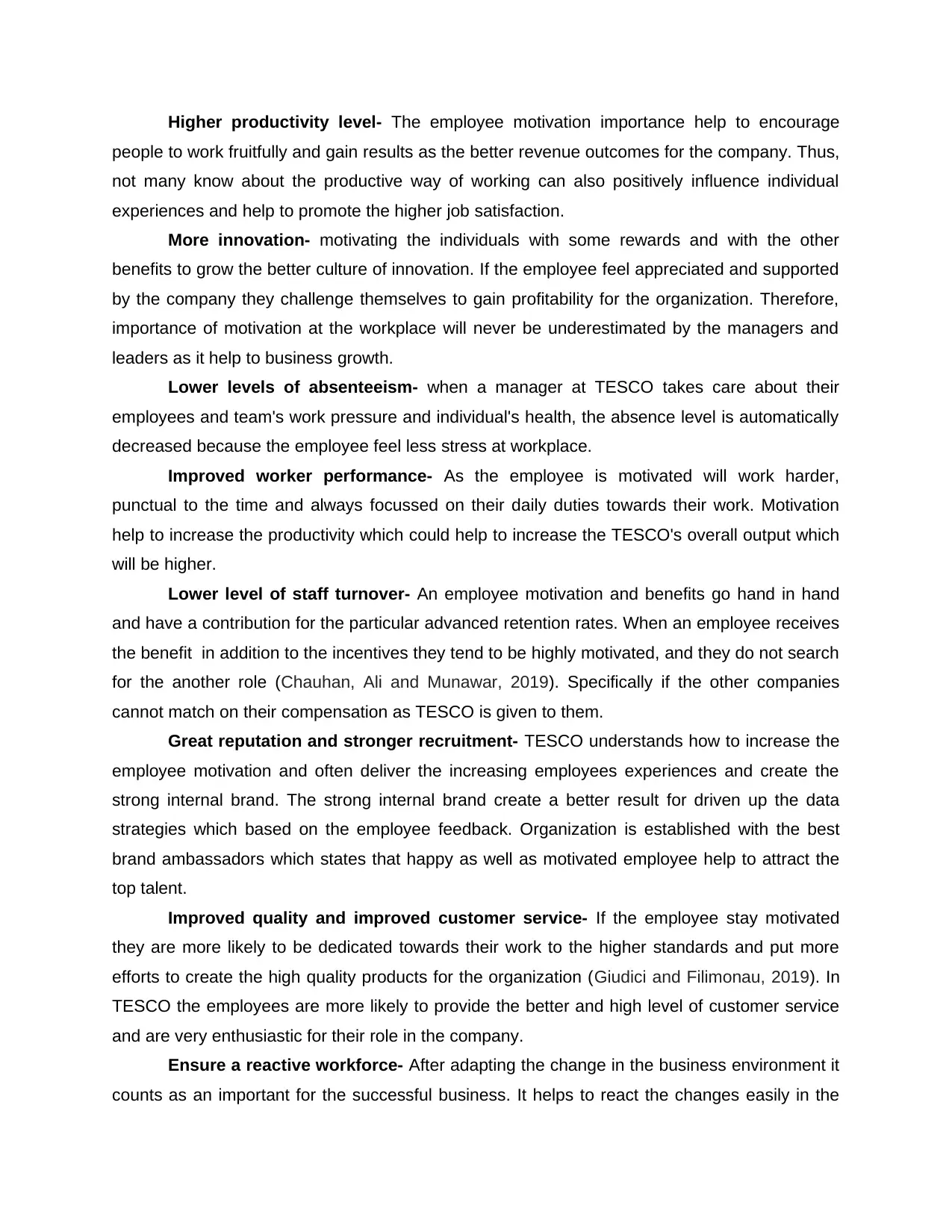
Higher productivity level- The employee motivation importance help to encourage
people to work fruitfully and gain results as the better revenue outcomes for the company. Thus,
not many know about the productive way of working can also positively influence individual
experiences and help to promote the higher job satisfaction.
More innovation- motivating the individuals with some rewards and with the other
benefits to grow the better culture of innovation. If the employee feel appreciated and supported
by the company they challenge themselves to gain profitability for the organization. Therefore,
importance of motivation at the workplace will never be underestimated by the managers and
leaders as it help to business growth.
Lower levels of absenteeism- when a manager at TESCO takes care about their
employees and team's work pressure and individual's health, the absence level is automatically
decreased because the employee feel less stress at workplace.
Improved worker performance- As the employee is motivated will work harder,
punctual to the time and always focussed on their daily duties towards their work. Motivation
help to increase the productivity which could help to increase the TESCO's overall output which
will be higher.
Lower level of staff turnover- An employee motivation and benefits go hand in hand
and have a contribution for the particular advanced retention rates. When an employee receives
the benefit in addition to the incentives they tend to be highly motivated, and they do not search
for the another role (Chauhan, Ali and Munawar, 2019). Specifically if the other companies
cannot match on their compensation as TESCO is given to them.
Great reputation and stronger recruitment- TESCO understands how to increase the
employee motivation and often deliver the increasing employees experiences and create the
strong internal brand. The strong internal brand create a better result for driven up the data
strategies which based on the employee feedback. Organization is established with the best
brand ambassadors which states that happy as well as motivated employee help to attract the
top talent.
Improved quality and improved customer service- If the employee stay motivated
they are more likely to be dedicated towards their work to the higher standards and put more
efforts to create the high quality products for the organization (Giudici and Filimonau, 2019). In
TESCO the employees are more likely to provide the better and high level of customer service
and are very enthusiastic for their role in the company.
Ensure a reactive workforce- After adapting the change in the business environment it
counts as an important for the successful business. It helps to react the changes easily in the
people to work fruitfully and gain results as the better revenue outcomes for the company. Thus,
not many know about the productive way of working can also positively influence individual
experiences and help to promote the higher job satisfaction.
More innovation- motivating the individuals with some rewards and with the other
benefits to grow the better culture of innovation. If the employee feel appreciated and supported
by the company they challenge themselves to gain profitability for the organization. Therefore,
importance of motivation at the workplace will never be underestimated by the managers and
leaders as it help to business growth.
Lower levels of absenteeism- when a manager at TESCO takes care about their
employees and team's work pressure and individual's health, the absence level is automatically
decreased because the employee feel less stress at workplace.
Improved worker performance- As the employee is motivated will work harder,
punctual to the time and always focussed on their daily duties towards their work. Motivation
help to increase the productivity which could help to increase the TESCO's overall output which
will be higher.
Lower level of staff turnover- An employee motivation and benefits go hand in hand
and have a contribution for the particular advanced retention rates. When an employee receives
the benefit in addition to the incentives they tend to be highly motivated, and they do not search
for the another role (Chauhan, Ali and Munawar, 2019). Specifically if the other companies
cannot match on their compensation as TESCO is given to them.
Great reputation and stronger recruitment- TESCO understands how to increase the
employee motivation and often deliver the increasing employees experiences and create the
strong internal brand. The strong internal brand create a better result for driven up the data
strategies which based on the employee feedback. Organization is established with the best
brand ambassadors which states that happy as well as motivated employee help to attract the
top talent.
Improved quality and improved customer service- If the employee stay motivated
they are more likely to be dedicated towards their work to the higher standards and put more
efforts to create the high quality products for the organization (Giudici and Filimonau, 2019). In
TESCO the employees are more likely to provide the better and high level of customer service
and are very enthusiastic for their role in the company.
Ensure a reactive workforce- After adapting the change in the business environment it
counts as an important for the successful business. It helps to react the changes easily in the
Paraphrase This Document
Need a fresh take? Get an instant paraphrase of this document with our AI Paraphraser
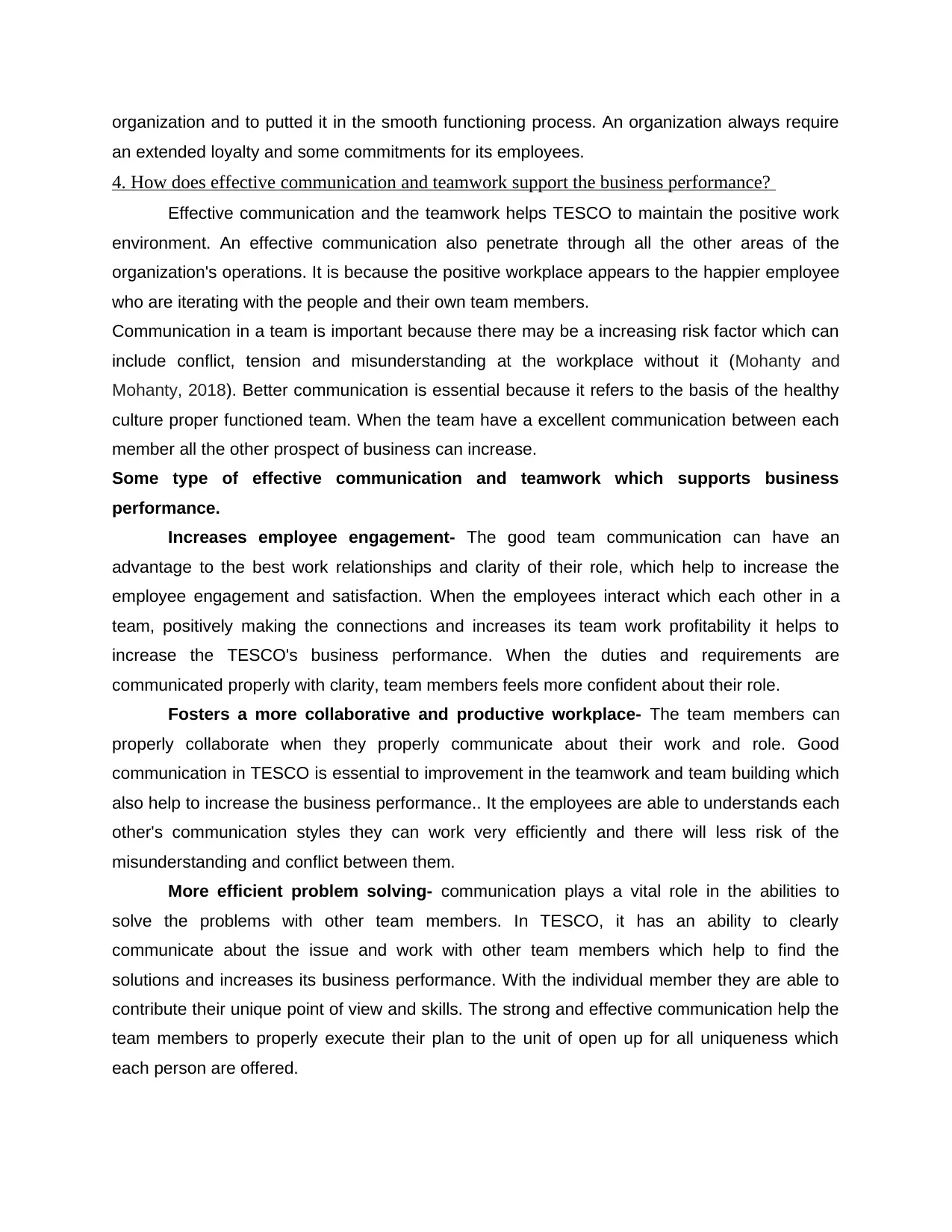
organization and to putted it in the smooth functioning process. An organization always require
an extended loyalty and some commitments for its employees.
4. How does effective communication and teamwork support the business performance?
Effective communication and the teamwork helps TESCO to maintain the positive work
environment. An effective communication also penetrate through all the other areas of the
organization's operations. It is because the positive workplace appears to the happier employee
who are iterating with the people and their own team members.
Communication in a team is important because there may be a increasing risk factor which can
include conflict, tension and misunderstanding at the workplace without it (Mohanty and
Mohanty, 2018). Better communication is essential because it refers to the basis of the healthy
culture proper functioned team. When the team have a excellent communication between each
member all the other prospect of business can increase.
Some type of effective communication and teamwork which supports business
performance.
Increases employee engagement- The good team communication can have an
advantage to the best work relationships and clarity of their role, which help to increase the
employee engagement and satisfaction. When the employees interact which each other in a
team, positively making the connections and increases its team work profitability it helps to
increase the TESCO's business performance. When the duties and requirements are
communicated properly with clarity, team members feels more confident about their role.
Fosters a more collaborative and productive workplace- The team members can
properly collaborate when they properly communicate about their work and role. Good
communication in TESCO is essential to improvement in the teamwork and team building which
also help to increase the business performance.. It the employees are able to understands each
other's communication styles they can work very efficiently and there will less risk of the
misunderstanding and conflict between them.
More efficient problem solving- communication plays a vital role in the abilities to
solve the problems with other team members. In TESCO, it has an ability to clearly
communicate about the issue and work with other team members which help to find the
solutions and increases its business performance. With the individual member they are able to
contribute their unique point of view and skills. The strong and effective communication help the
team members to properly execute their plan to the unit of open up for all uniqueness which
each person are offered.
an extended loyalty and some commitments for its employees.
4. How does effective communication and teamwork support the business performance?
Effective communication and the teamwork helps TESCO to maintain the positive work
environment. An effective communication also penetrate through all the other areas of the
organization's operations. It is because the positive workplace appears to the happier employee
who are iterating with the people and their own team members.
Communication in a team is important because there may be a increasing risk factor which can
include conflict, tension and misunderstanding at the workplace without it (Mohanty and
Mohanty, 2018). Better communication is essential because it refers to the basis of the healthy
culture proper functioned team. When the team have a excellent communication between each
member all the other prospect of business can increase.
Some type of effective communication and teamwork which supports business
performance.
Increases employee engagement- The good team communication can have an
advantage to the best work relationships and clarity of their role, which help to increase the
employee engagement and satisfaction. When the employees interact which each other in a
team, positively making the connections and increases its team work profitability it helps to
increase the TESCO's business performance. When the duties and requirements are
communicated properly with clarity, team members feels more confident about their role.
Fosters a more collaborative and productive workplace- The team members can
properly collaborate when they properly communicate about their work and role. Good
communication in TESCO is essential to improvement in the teamwork and team building which
also help to increase the business performance.. It the employees are able to understands each
other's communication styles they can work very efficiently and there will less risk of the
misunderstanding and conflict between them.
More efficient problem solving- communication plays a vital role in the abilities to
solve the problems with other team members. In TESCO, it has an ability to clearly
communicate about the issue and work with other team members which help to find the
solutions and increases its business performance. With the individual member they are able to
contribute their unique point of view and skills. The strong and effective communication help the
team members to properly execute their plan to the unit of open up for all uniqueness which
each person are offered.

Better conflict resolution- In any team conflicts are usually arrives along with everyone
who are tackling it along. Lack of communication can only contributes to some issues which can
increase the tension and enmity in a work environment (Niati, Siregar and Prayoga, 2021). If the
individual team understands communicating with each other when such type of the conflicts
arises. The employees get better to be equipped to the work through these problems. Some
employees are able to be direct to the confrontation to the other employee and some are may
shy to avoid such type of conversation.
It makes easier to reach goals- communicating properly and effectively helps to
improve the work performance and help TESCO to implement such strategies to meet their
business targets and establishment towards their objectives. With the proper communication
practices organization may contour the projects and work towards the common goal which can
be much easier because company takes everyone at the same page.
Better transparency- In TESCO the energy is shared and the positive relationships
between the team members are built by conducting the workplace transparency which is being
surrounded by the secrets and some hidden information which create the uncontrollability at the
workplace and reduces the business performance ability. It helps to create the trustworthy
workplace which is used by the informations which help too openly share between the team
members across any level of the business.
Develop the employee skills- The team who communicate effectively will help to
business to develop their performance. Whereas, collaboration allows the employees to gain the
proper knowledge perception from the employees to improve their working skills. The effective
communication in the team members will give a clear evaluation for their skills and their
performance (Tseng, Yi and Yeh, 2019). Open the feedback channel to set the benchmarks for
the employees and to learn about their shortcomings and strengths. It not only help employee to
improve their working quality it will help the business as well to improve its performance.
CONCLUSION
From the above discussion, it has been concluded that with the help of operational
management's support the business has achieved it targets, aims and objectives. While it
shows the two management approaches which are scientific approach and administrative
approach which help to increase the production by increasing the individual's productivity.
Furthermore, motivated employee is a precious asset for the organization who help them to
maintaining and increasing the business income and growth. Moreover, the employee
motivation is necessary to acquire the organizational success. If they are not motivated properly
management can fail to achieve their goal effectively. Furthermore, it shows that proper and
who are tackling it along. Lack of communication can only contributes to some issues which can
increase the tension and enmity in a work environment (Niati, Siregar and Prayoga, 2021). If the
individual team understands communicating with each other when such type of the conflicts
arises. The employees get better to be equipped to the work through these problems. Some
employees are able to be direct to the confrontation to the other employee and some are may
shy to avoid such type of conversation.
It makes easier to reach goals- communicating properly and effectively helps to
improve the work performance and help TESCO to implement such strategies to meet their
business targets and establishment towards their objectives. With the proper communication
practices organization may contour the projects and work towards the common goal which can
be much easier because company takes everyone at the same page.
Better transparency- In TESCO the energy is shared and the positive relationships
between the team members are built by conducting the workplace transparency which is being
surrounded by the secrets and some hidden information which create the uncontrollability at the
workplace and reduces the business performance ability. It helps to create the trustworthy
workplace which is used by the informations which help too openly share between the team
members across any level of the business.
Develop the employee skills- The team who communicate effectively will help to
business to develop their performance. Whereas, collaboration allows the employees to gain the
proper knowledge perception from the employees to improve their working skills. The effective
communication in the team members will give a clear evaluation for their skills and their
performance (Tseng, Yi and Yeh, 2019). Open the feedback channel to set the benchmarks for
the employees and to learn about their shortcomings and strengths. It not only help employee to
improve their working quality it will help the business as well to improve its performance.
CONCLUSION
From the above discussion, it has been concluded that with the help of operational
management's support the business has achieved it targets, aims and objectives. While it
shows the two management approaches which are scientific approach and administrative
approach which help to increase the production by increasing the individual's productivity.
Furthermore, motivated employee is a precious asset for the organization who help them to
maintaining and increasing the business income and growth. Moreover, the employee
motivation is necessary to acquire the organizational success. If they are not motivated properly
management can fail to achieve their goal effectively. Furthermore, it shows that proper and
⊘ This is a preview!⊘
Do you want full access?
Subscribe today to unlock all pages.

Trusted by 1+ million students worldwide

loyal teamwork has a great impact on the organizational performance as well as the effective
communication supports the business performance with the help of the proper communications
between the employees and team members.
communication supports the business performance with the help of the proper communications
between the employees and team members.
Paraphrase This Document
Need a fresh take? Get an instant paraphrase of this document with our AI Paraphraser
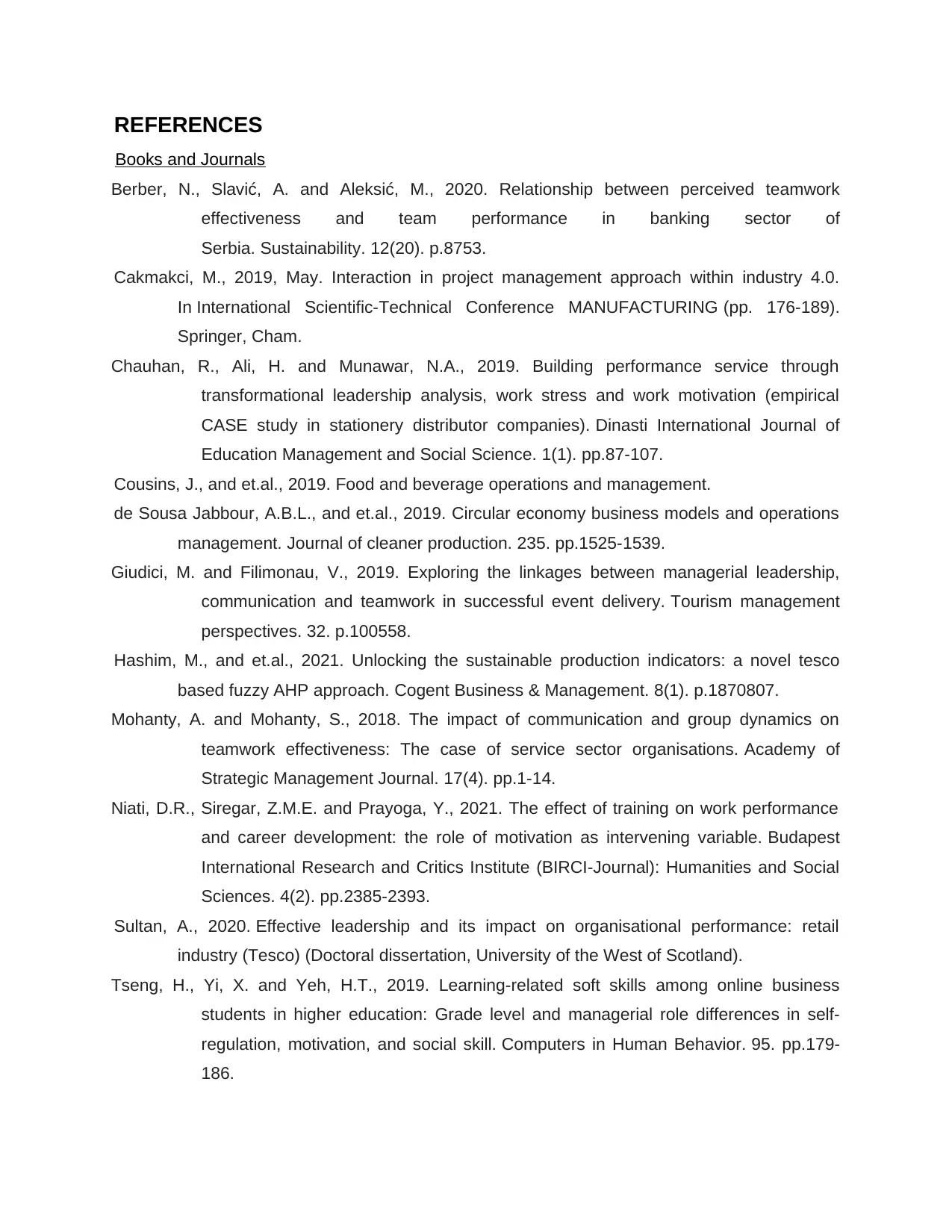
REFERENCES
Books and Journals
Berber, N., Slavić, A. and Aleksić, M., 2020. Relationship between perceived teamwork
effectiveness and team performance in banking sector of
Serbia. Sustainability. 12(20). p.8753.
Cakmakci, M., 2019, May. Interaction in project management approach within industry 4.0.
In International Scientific-Technical Conference MANUFACTURING (pp. 176-189).
Springer, Cham.
Chauhan, R., Ali, H. and Munawar, N.A., 2019. Building performance service through
transformational leadership analysis, work stress and work motivation (empirical
CASE study in stationery distributor companies). Dinasti International Journal of
Education Management and Social Science. 1(1). pp.87-107.
Cousins, J., and et.al., 2019. Food and beverage operations and management.
de Sousa Jabbour, A.B.L., and et.al., 2019. Circular economy business models and operations
management. Journal of cleaner production. 235. pp.1525-1539.
Giudici, M. and Filimonau, V., 2019. Exploring the linkages between managerial leadership,
communication and teamwork in successful event delivery. Tourism management
perspectives. 32. p.100558.
Hashim, M., and et.al., 2021. Unlocking the sustainable production indicators: a novel tesco
based fuzzy AHP approach. Cogent Business & Management. 8(1). p.1870807.
Mohanty, A. and Mohanty, S., 2018. The impact of communication and group dynamics on
teamwork effectiveness: The case of service sector organisations. Academy of
Strategic Management Journal. 17(4). pp.1-14.
Niati, D.R., Siregar, Z.M.E. and Prayoga, Y., 2021. The effect of training on work performance
and career development: the role of motivation as intervening variable. Budapest
International Research and Critics Institute (BIRCI-Journal): Humanities and Social
Sciences. 4(2). pp.2385-2393.
Sultan, A., 2020. Effective leadership and its impact on organisational performance: retail
industry (Tesco) (Doctoral dissertation, University of the West of Scotland).
Tseng, H., Yi, X. and Yeh, H.T., 2019. Learning-related soft skills among online business
students in higher education: Grade level and managerial role differences in self-
regulation, motivation, and social skill. Computers in Human Behavior. 95. pp.179-
186.
Books and Journals
Berber, N., Slavić, A. and Aleksić, M., 2020. Relationship between perceived teamwork
effectiveness and team performance in banking sector of
Serbia. Sustainability. 12(20). p.8753.
Cakmakci, M., 2019, May. Interaction in project management approach within industry 4.0.
In International Scientific-Technical Conference MANUFACTURING (pp. 176-189).
Springer, Cham.
Chauhan, R., Ali, H. and Munawar, N.A., 2019. Building performance service through
transformational leadership analysis, work stress and work motivation (empirical
CASE study in stationery distributor companies). Dinasti International Journal of
Education Management and Social Science. 1(1). pp.87-107.
Cousins, J., and et.al., 2019. Food and beverage operations and management.
de Sousa Jabbour, A.B.L., and et.al., 2019. Circular economy business models and operations
management. Journal of cleaner production. 235. pp.1525-1539.
Giudici, M. and Filimonau, V., 2019. Exploring the linkages between managerial leadership,
communication and teamwork in successful event delivery. Tourism management
perspectives. 32. p.100558.
Hashim, M., and et.al., 2021. Unlocking the sustainable production indicators: a novel tesco
based fuzzy AHP approach. Cogent Business & Management. 8(1). p.1870807.
Mohanty, A. and Mohanty, S., 2018. The impact of communication and group dynamics on
teamwork effectiveness: The case of service sector organisations. Academy of
Strategic Management Journal. 17(4). pp.1-14.
Niati, D.R., Siregar, Z.M.E. and Prayoga, Y., 2021. The effect of training on work performance
and career development: the role of motivation as intervening variable. Budapest
International Research and Critics Institute (BIRCI-Journal): Humanities and Social
Sciences. 4(2). pp.2385-2393.
Sultan, A., 2020. Effective leadership and its impact on organisational performance: retail
industry (Tesco) (Doctoral dissertation, University of the West of Scotland).
Tseng, H., Yi, X. and Yeh, H.T., 2019. Learning-related soft skills among online business
students in higher education: Grade level and managerial role differences in self-
regulation, motivation, and social skill. Computers in Human Behavior. 95. pp.179-
186.
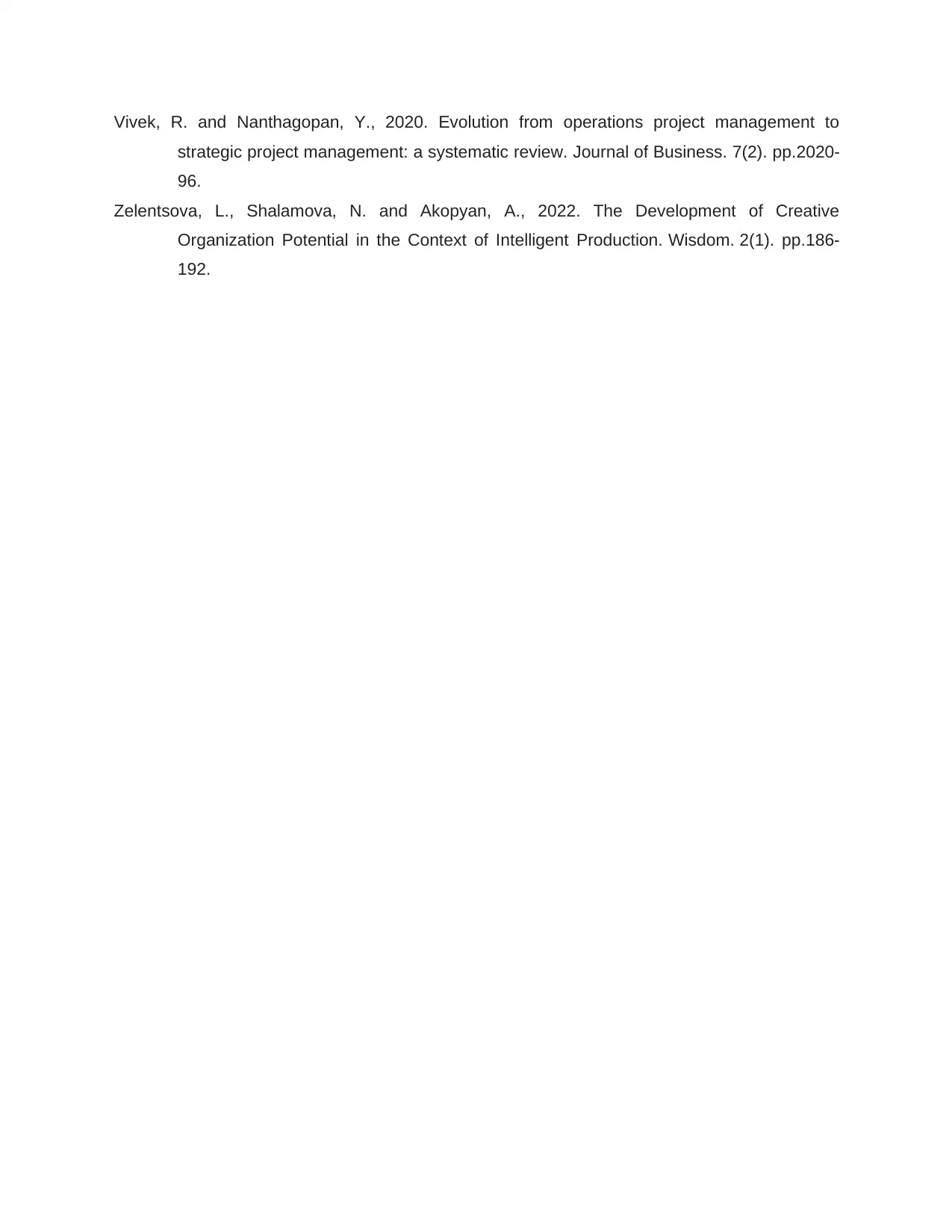
Vivek, R. and Nanthagopan, Y., 2020. Evolution from operations project management to
strategic project management: a systematic review. Journal of Business. 7(2). pp.2020-
96.
Zelentsova, L., Shalamova, N. and Akopyan, A., 2022. The Development of Creative
Organization Potential in the Context of Intelligent Production. Wisdom. 2(1). pp.186-
192.
strategic project management: a systematic review. Journal of Business. 7(2). pp.2020-
96.
Zelentsova, L., Shalamova, N. and Akopyan, A., 2022. The Development of Creative
Organization Potential in the Context of Intelligent Production. Wisdom. 2(1). pp.186-
192.
⊘ This is a preview!⊘
Do you want full access?
Subscribe today to unlock all pages.

Trusted by 1+ million students worldwide
1 out of 12
Related Documents
Your All-in-One AI-Powered Toolkit for Academic Success.
+13062052269
info@desklib.com
Available 24*7 on WhatsApp / Email
![[object Object]](/_next/static/media/star-bottom.7253800d.svg)
Unlock your academic potential
Copyright © 2020–2025 A2Z Services. All Rights Reserved. Developed and managed by ZUCOL.





